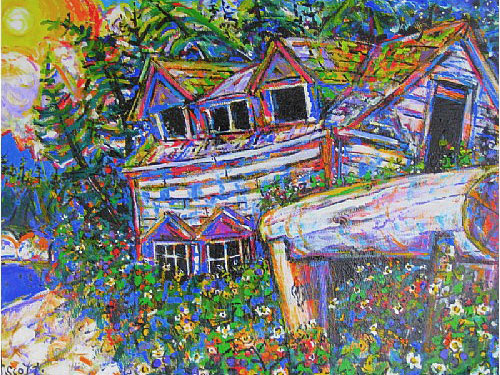Mamilikulla ,Page 52 in Book 3 Forty Paintings and Stories of the Working Coast. Mamililikula or village island is iconic on the BC Coast. Linda and Paul MacCartnay visited the Chief Jimmy Seaweed rushed around the island to get an autograph ripped the door off the outhouse Sir Paul signed, it hangs in Jimmy’s long house. The chief stands on the beach in his regalia relates all the folk lore of the local geography In my painting are the house posts of the long house with the houses built later by the government. – Acrylic on Canvas
$3,450.00
30″x40″ Acrylic on canvas.
| Dimensions | 30 × 40 in |
|---|
1 in stock
Description
Mamilikulla
30″x40″
Acrylic on canvas.
The Inspiration
This beautiful Island once boasted a thriving village with spectacular totem poles attesting to the wealth of the First Nations Band, the Kwakiutl. Ample food sources allowed the north coast Indians free time to devote to cultural activities and the wealth to enrich their lives.
With a large sandy beach, Mamalilikulla provided vast quantities of clams. The clam was a significant source of nutrition year-round.
Salmon was a very seasonal food source. Filling the rivers to overflow late summer to fall, these silver beauties were out at sea the remainder of the year.
Even though First Nations people were expert at smoking and preserving salmon, they needed additional food sources throughout the remainder of the year. Crab, clams, mussels, and wide variety of smaller fish filled the gaps. Gathering and storing berries was also very important. Camus, a tuber producing plant, provided a carbohydrate.
lnterestingly, the Pacific Oyster, now so synonymous with the BC Coast, was an introduction from Japan in the 19th century.
You didn’t starve on the north BC Coast. Jame Sewid, the first elected Chief of the Kwakiutl Band, wrote a monumental book on First Nations life that was entitled, significantly: “Guests Never Leave Hungry”.
The richness of the land and sea created the richness in art and culture on the BC coast.
Very little remains in Mamililikulla. Remnants of the Chief’s house and evidence of fallen totem poles attest to the past glories. The beach and mountains are picturesque with many small islands and swirling eddies as the tides ebb and flow.
Killer Whales (Orcas) frequent the area, as well as eagles, Pacific Porpoise, Harbor Seals, and Sea Lions. Mamililikulla is both a melancholy and monumental celebration of a rich and vibrant culture.

Reviews
There are no reviews yet.